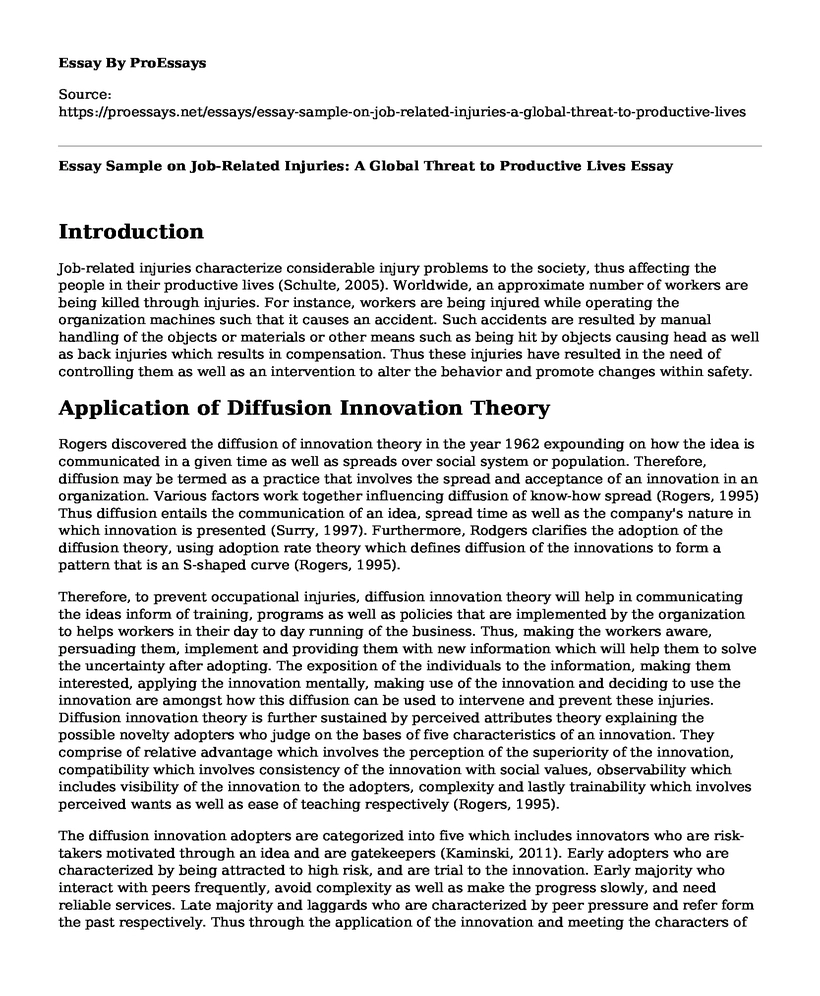Introduction
Job-related injuries characterize considerable injury problems to the society, thus affecting the people in their productive lives (Schulte, 2005). Worldwide, an approximate number of workers are being killed through injuries. For instance, workers are being injured while operating the organization machines such that it causes an accident. Such accidents are resulted by manual handling of the objects or materials or other means such as being hit by objects causing head as well as back injuries which results in compensation. Thus these injuries have resulted in the need of controlling them as well as an intervention to alter the behavior and promote changes within safety.
Application of Diffusion Innovation Theory
Rogers discovered the diffusion of innovation theory in the year 1962 expounding on how the idea is communicated in a given time as well as spreads over social system or population. Therefore, diffusion may be termed as a practice that involves the spread and acceptance of an innovation in an organization. Various factors work together influencing diffusion of know-how spread (Rogers, 1995) Thus diffusion entails the communication of an idea, spread time as well as the company's nature in which innovation is presented (Surry, 1997). Furthermore, Rodgers clarifies the adoption of the diffusion theory, using adoption rate theory which defines diffusion of the innovations to form a pattern that is an S-shaped curve (Rogers, 1995).
Therefore, to prevent occupational injuries, diffusion innovation theory will help in communicating the ideas inform of training, programs as well as policies that are implemented by the organization to helps workers in their day to day running of the business. Thus, making the workers aware, persuading them, implement and providing them with new information which will help them to solve the uncertainty after adopting. The exposition of the individuals to the information, making them interested, applying the innovation mentally, making use of the innovation and deciding to use the innovation are amongst how this diffusion can be used to intervene and prevent these injuries. Diffusion innovation theory is further sustained by perceived attributes theory explaining the possible novelty adopters who judge on the bases of five characteristics of an innovation. They comprise of relative advantage which involves the perception of the superiority of the innovation, compatibility which involves consistency of the innovation with social values, observability which includes visibility of the innovation to the adopters, complexity and lastly trainability which involves perceived wants as well as ease of teaching respectively (Rogers, 1995).
The diffusion innovation adopters are categorized into five which includes innovators who are risk-takers motivated through an idea and are gatekeepers (Kaminski, 2011). Early adopters who are characterized by being attracted to high risk, and are trial to the innovation. Early majority who interact with peers frequently, avoid complexity as well as make the progress slowly, and need reliable services. Late majority and laggards who are characterized by peer pressure and refer form the past respectively. Thus through the application of the innovation and meeting the characters of the innovation, the adoption of the process will be of importance in reducing the injury through the diffusion of the new way of solving the problem (Rogers et al., 2005). Besides, changing the physical surrounding aides in preventing the injury. This physical surrounding is characterized by manmade objects and structures, slopes and regular temperatures which results in injury control intervention.
The strength of the diffusion innovation theory in the intervention of injury prevention is that it will enable reaching of the new target group as well as existing innovation, encouragement, support and administration, hence use of the new technology in teaching as well as communicating new information which will help in injury control. On the other hand, the limitation of diffusion innovation theory comprises of evidence that addresses the adopter's groups and not addressing health and openly not to adopt new behavior as well as health innovation (Miller, 2005).
References
Kaminski, J. (2011). Diffusion of innovation theory. Canadian Journal of Nursing Informatics, 6(2), 1-6.
Miller, R. L. (2015). Rogers' innovation diffusion theory (1962, 1995). In Information seeking behavior and technology adoption: Theories and trends (pp. 261-274). IGI Global.
Rogers, E. M. (1995). Diffusion of innovations (4th ed.). New York: The Free Press.
Rogers, E. M., Medina, U. E., Rivera, M. A., & Wiley, C. J. (2005). Complex adaptive systems and the diffusion of innovations. The Innovation Journal: The Public Sector Innovation Journal, 10(3), 1-26.
Schulte, P. A. (2005). Characterizing the burden of occupational injury and disease. Journal of Occupational and Environmental Medicine, 47(6), 607-622.
Surry, D. W. (1997). Diffusion Theory and Instructional Technology.
Cite this page
Essay Sample on Job-Related Injuries: A Global Threat to Productive Lives. (2023, May 07). Retrieved from https://proessays.net/essays/essay-sample-on-job-related-injuries-a-global-threat-to-productive-lives
If you are the original author of this essay and no longer wish to have it published on the ProEssays website, please click below to request its removal:
- Intercultural Learning, Global Health, and Nursing: Teaching and Learning Strategies
- Reflection of Nursing Knowledge
- Health Disparities Among the Hispanic Community Essay
- The Influence of Antidiabetic Medications on the Development and Progression of Prostate Cancer
- Essay Sample on Noise-Induced Hearing Loss: How Loud Environments Damage Our Hearing
- Roles of RNs & Nurse Leaders in Changing Healthcare: Evidence-Based Practice, Issues & Trends - Essay Sample
- Cholera: A Waterborne Disease & Its Seasonal Patterns - Essay Sample







